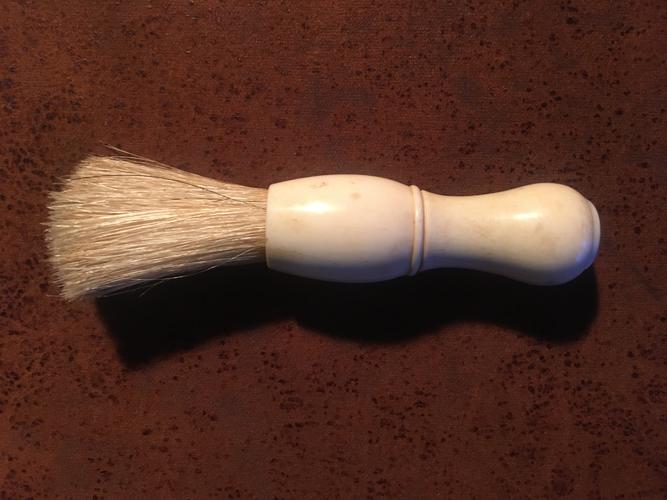Results 1 to 10 of 19
Thread: Ivory handled brush...maybe
-
01-13-2020, 01:51 AM #1
 Ivory handled brush...maybe
Ivory handled brush...maybe


Hi Folks, this is a brush that I recently acquired. It was one of a few items In A package of various shave items. It is not branded, looks to have been turned on a lathe, and appears to be Ivory. Was Ivory a common brush material? Any insight into the age of this brush? I am pretty well versed on straight razor history but know next to nothing about brushes. Any info on this one that folks are willing to contribute would be greatly appreciated. Thanks in advance.
-
01-13-2020, 11:24 AM #2

They did make ivory handled brushes but ivory usually has a subtle grain pattern to it. can you see any grain?
-
01-13-2020, 12:30 PM #3

I would say it is not bone.
But, saying it is not antiquated, it could be ivory.
I remember Pixel saying you had to use a metal lathe to turn ivory. Wood lathes produced a lot of chatter marks.If you don't care where you are, you are not lost.
-
01-13-2020, 01:15 PM #4Senior Member



- Join Date
- Apr 2012
- Location
- Diamond Bar, CA
- Posts
- 6,553
Thanked: 3215
A better pic of the end may tell you more, probably bone.
If it was it would probably have been knotted in Badger, not boar. Ivory was used judicially for top of the line goods.
Nice find.
-
01-13-2020, 01:26 PM #5Aristocratic treasure hunter


- Join Date
- Nov 2013
- Location
- Saint Marcellin, France
- Posts
- 420
Thanked: 154
Well, there are several ways to know whether it's ivory or not.
Up close, ivory has lines, "Schreger lines", that may or may not cross. But it's quite unmistakable.
A sure way to know is to apply a red hot needle to a part. It should hardly penetrate, and if it smells of bone, it should be really light. Bone will be penetrated deeper and have a strong smell.Beautiful is important, but when all is said and done, you will always be faithful to a good shaver while a bad one may detter you from ever trying again. Judge with your skin, not your eyes.
-
01-13-2020, 02:04 PM #6

It's possible to be some sort of thermoplastic and a hot pin would melt/damage it leaving a mark. If it's bone of ivory it shouldn't leave a mark. In that case those are fairly easy to tell apart - bone has blood vessels through out so it has small pores you can see esp under magnification. OTOH ivory has the famous "Schreger lines".
Let us know the outcome!
-
01-13-2020, 02:37 PM #7

Appreciate the input. I have seen the grain that Ivory has on my ivory scaled straights. I do not see these lines on this particular brush handle. On the other hand, I also do not see the unmistakable pores that are apparent on bone scales. Hence my confusion. When I get home tonight I will try to capture the lathe markings on the end of the handle. Maybe, I am off base and its actually plastic or an early version of plastic but I was under the assumption that a polymer would be poured and not put on a lathe. Anyway, I will try to examine a bit closer and post pics. Thanks a bunch and stay tuned.
-
01-13-2020, 03:18 PM #8

It doesn't look like Ivory at all and ivory would only be used in top of the line Badger brushes. It has always been a luxury material.
No matter how many men you kill you can't kill your successor-Emperor Nero
-
01-13-2020, 05:03 PM #9

I'm going with Gugi based on the latest input from the OP.
Randydance had a brush made by Skip Nordstrom. He poured it and turned it on a wood lathe. It looks very similar to this..If you don't care where you are, you are not lost.
-
01-13-2020, 05:37 PM #10Senior Member



- Join Date
- Mar 2012
- Location
- Thunder Bay, Ontario, Canada
- Posts
- 17,312
Thanked: 3228
IIRC our departed resident ivory guru Pixelfixed mentioned that it depends on how the ivory is cut and from where one the tusk it was taken whether or not the ivory will have "Schreger lines" visible in it. Ivory with "Schreger lines" being higher quality that that without.
That said, my biggest doubts about the handle being ivory are it's fairly large size and the knot being boar. Badger has always been considered the premium knot material and ivory handles usually were associated with those knots.
BobLife is a terminal illness in the end


 69Likes
69Likes LinkBack URL
LinkBack URL About LinkBacks
About LinkBacks






 Reply With Quote
Reply With Quote




